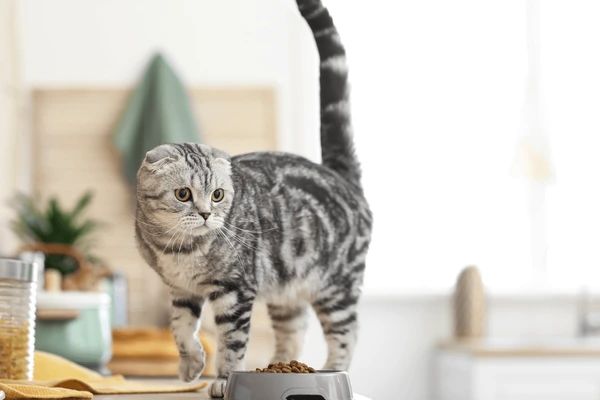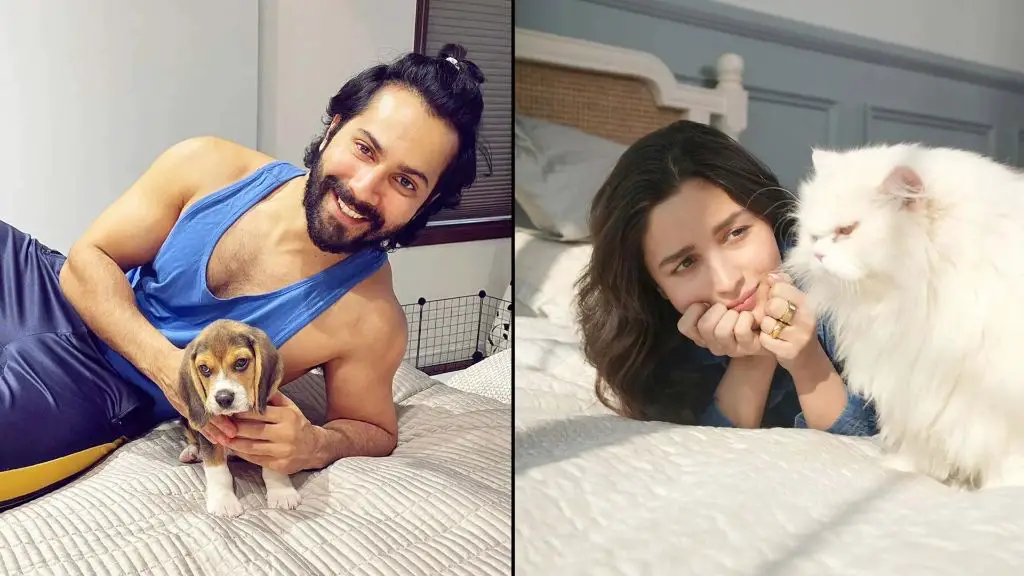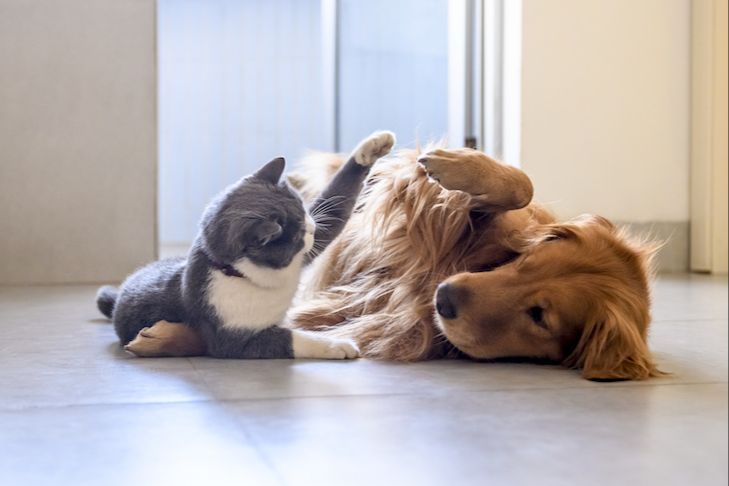Having both dogs and cats in the home can create unique challenges when it comes to feeding them. While cat food is specifically formulated to meet the nutritional needs of cats, it can be very tempting and appealing to dogs. Dogs are omnivores and can eat a wide variety of foods, but cat food is not ideal for their health and wellbeing. The high protein and fat content in cat food can cause gastrointestinal upset, pancreatitis, and obesity in dogs if they eat it regularly. Storing and feeding cat food safely is crucial in a multi-pet household to prevent the dog from getting into it.
Dangers of Dogs Eating Cat Food
There are some important nutritional differences between dog and cat food that make feeding only cat food dangerous for dogs [1]. Cat food is much higher in protein and fat than dog food. While proteins and fats are essential nutrients for dogs, excessive amounts can lead to obesity and other health problems like pancreatitis. Cat food also contains higher levels of vitamins and minerals like vitamin A and taurine. Too much vitamin A can cause joint pain and vision problems in dogs.
Additionally, cat food is deficient in certain nutrients dogs need. Dog food contains more vitamin B6, vitamin C, and niacin than cat food. A lack of these vitamins can cause skin problems, diarrhea, and anemia in dogs. Most importantly, cat food does not have enough calcium or phosphorus, which are critical for bone health. Feeding only cat food can result in nutritional deficiencies and bone disease for dogs over time.
While an occasional bite of cat food won’t harm dogs, cat food should never make up the bulk of any dog’s diet. Sticking to properly formulated dog food provides the right balance of nutrients for a dog’s health.
Store Cat Food Up High
One effective strategy to keep dogs from eating cat food is to store the cat food bowls up high where dogs can’t reach. According to the American National Standards Institute, the standard kitchen counter height is 36 inches (see https://www.angi.com/articles/standard-counter-height.htm). This is typically too high for most dogs to reach. You can place cat food bowls on the kitchen counter or any other high shelves or surfaces at least 36 inches off the ground.

The key is keeping the cat food completely out of reach of dogs. If your dog is tall or an excellent jumper, you may need to store cat food even higher than the standard counter height. Place it at the highest spot your cats can still comfortably access. This could be on top of the refrigerator, deep cupboards, or cat trees and furniture designed for felines.
Use Pet Gates
One effective way to keep your dog from getting into the cat’s food is by using pet gates to block access to areas where the cat food is stored. Pet gates allow you to restrict your dog’s access while still giving your cat the ability to freely jump over the gate to eat.
When selecting a pet gate, opt for one that is tall enough so your dog can’t jump over it. Look for gates that are at least 3-4 feet high for medium to large dogs. For small dogs, a gate around 2 feet high should suffice. You’ll also want to make sure the gate is sturdy and secure, so your dog can’t knock it down. The best pet gates often have features like adjustable width, a walk-through design, and hardware or pressure mounts to securely install them.
Strategically place gates in doorways or openings leading to areas like the laundry room, garage, or kitchen pantry where the cat food is stored. This will physically block your dog from getting to the food while still allowing your cat access by jumping over or slipping through the bars. Just be sure not to completely restrict your cat’s ability to easily reach their food and water.

With sturdy, properly positioned pet gates, you can effectively keep your dog out of the cat food while avoiding dangerous encounters between your pets. The gates provide a simple solution to confine your dog without having to completely isolate your cat from the household.
Lock Cat Food in Containers
One effective way to keep dogs out of the cat food is to store it in airtight containers with locking lids. The locked lids help contain the smell of the cat food, making it less enticing to dogs. Look for sturdy plastic containers made specifically for pet food storage. Some good options are the IRIS Premium Airtight Pet Food Containers or the Vittles Vault Pet Food Storage Containers.
The Iris Premium Pet Food Container comes in sizes ranging from 2.2 gallons to 60 gallons and has a snap-lock lid to securely contain odors (Chewy.com). This helps prevent dogs from smelling the cat food and prevents crowding or ants. The Vittles Vault Pet Food Storage option also has an airtight seal and stackable designs great for small spaces (Amazon.com). Investing in airtight storage containers is a simple way to restrict your dog’s access to the cat food.
Feed Cats in Closet or Bathroom
One effective method to keep dogs out of the cat food is to designate a pet-safe closet or bathroom where you can feed the cats. Choose a room that you can close off and the dog can’t access. This allows the cats to eat their meals in peace without the dog barging in and trying to steal their food. Be sure the room is “cat-proofed” by removing anything dangerous or toxic.
Try setting up a cat feeding station in a bathroom or pantry. Place the cat food bowls and water on an elevated surface or inside a cabinet the dog can’t reach. Feed them on a schedule, then when they are done eating, let them out and close the door again. This separates the cat feeding area so the dog learns he can’t get to the cat food. Training the dog to wait outside the room while the cats eat can help reinforce this.
Feeding cats in an enclosed room prevents food theft and allows them to eat stress-free in a safe, dog-free zone. Just be sure the room is ventilated, pet-safe, and easy to clean. This can help establish a routine so the cats and dog know that cat mealtimes are separate.
Feed Cats More Frequently
One effective strategy to prevent dogs from eating cat food is to feed cats smaller meals more frequently throughout the day. The American Animal Hospital Association recommends feeding adult cats 2-3 times per day https://www.animalhumanesociety.org/resource/feeding-your-dog-or-cat. This allows you to provide the necessary daily nutrition while avoiding leaving large amounts of food out for long periods of time.
With more frequent feedings, cats are less likely to gorge and overeat. Their food is also fresher. Plus, there is less cat food available for the dog to get into between feedings. Feed cats at designated meal times instead of free feeding. Pick up any uneaten food after 20-30 minutes so the dog can’t get to it later.
Make sure to take the dog outside or confine it before putting the cat food down. Stay nearby during cat mealtimes to shoosh the dog away if it approaches. With this method, the cat food is out for shorter periods so there is less opportunity for the dog to eat it.
Create a Routine
Establishing a regular routine for feeding your cat and dog separately can help prevent the dog from getting into the cat’s food. Feed your pets at the same times each day, but schedule their meals for different times. For example, you can feed the dog breakfast at 7am and dinner at 5pm, while feeding the cat at 8am and 6pm. Feeding about 12 hours apart allows time for digestion while preventing your pets from feeling constantly hungry.
In addition to meal times, you’ll want to establish separate feeding locations for your cat and dog. Feed your cat up high on a cat tree, windowsill, or countertop where the dog can’t reach. Or place your cat’s food inside a closet or bathroom and shut the door while your cat eats. Your dog should be fed in their regular bowl in an open area like the kitchen.
Use Distractions
One effective way to keep your dog from eating the cat’s food is to distract them during cat feeding times. You can occupy your dog with an engaging activity like a food puzzle toy, playing fetch, or taking them on a short walk. The goal is to keep your dog mentally stimulated and focused on something other than the cat’s food.

Try feeding your cat when you are able to actively engage with your dog. For example, you could give your dog a Kong stuffed with peanut butter or their own meal just as you are feeding the cat. You can also use training sessions as a distraction. Ask your dog to practice known cues and reward with praise and treats while the cat eats.
Over time, your dog will get used to their own special activity during cat feeding times. Be sure to provide plenty of enrichment at other times as well so your dog is not always expecting food when the cat eats. With persistence and consistency, the distraction method can be effective at deterring food thievery behaviors.
For more on occupying dogs when cats eat, check out this source: How to Stop Your Dog From Eating Cat Food
Train Your Dog
One of the most effective ways to keep your dog from eating the cat’s food is to train them to “leave it”. Start by teaching your dog the “leave it” command using treats. Place a treat on the floor and when your dog goes for it, say “leave it” in a firm tone. Praise and reward your dog when they resist the temptation to eat the treat. Once they understand this command, practice it around the cat’s food. Place your dog on a leash so you can correct them from eating the food. Say “leave it” each time they go near the cat bowl. With enough repetition, your dog will learn not to touch the cat food when you give the command. Be sure to heavily praise and reward them when they resist. To reinforce it further, leave treats around the cat bowl and practice the “leave it” command. With consistent training, your dog will stop viewing the cat food as something they’re allowed to eat.

